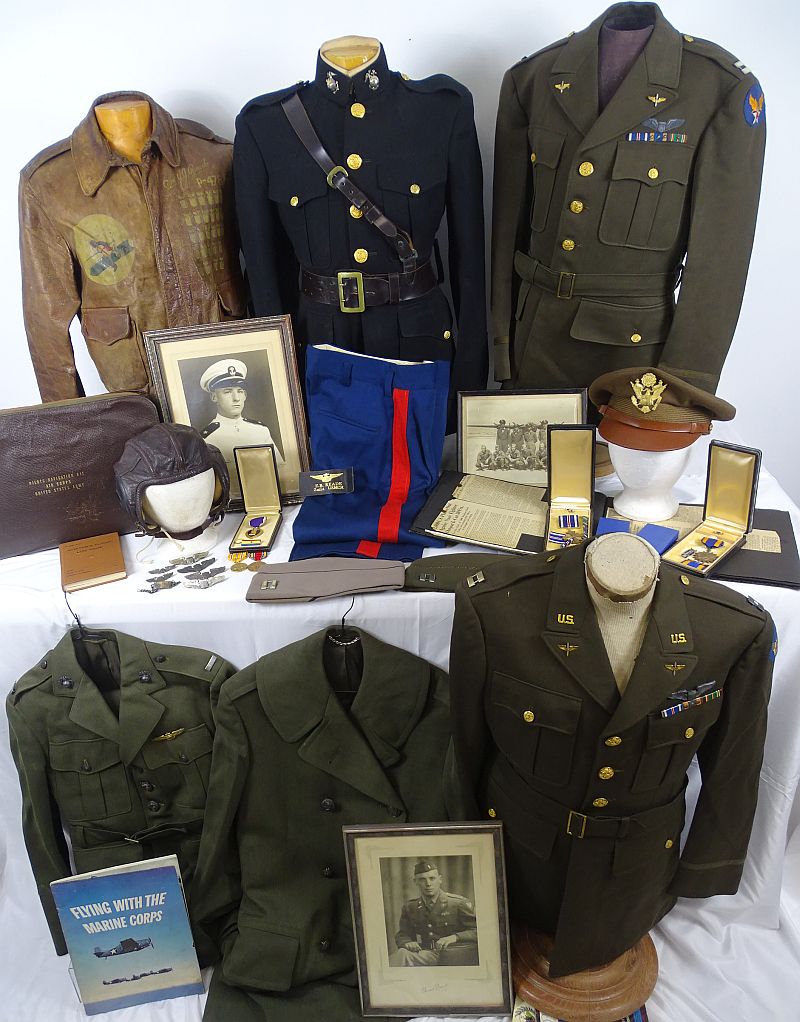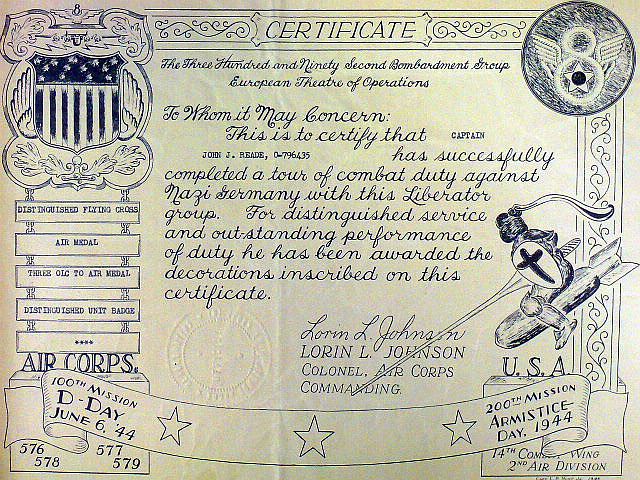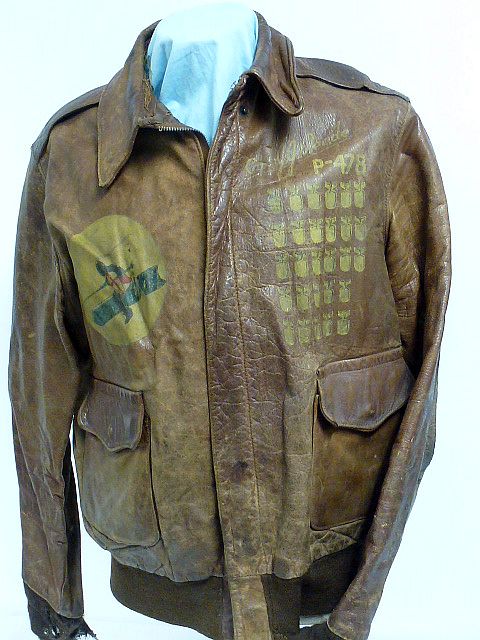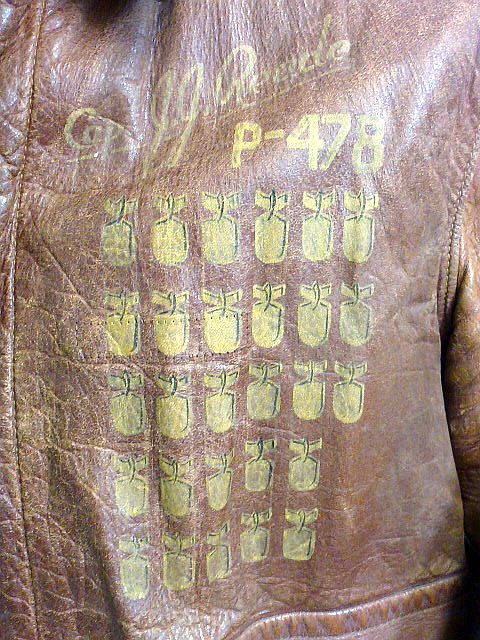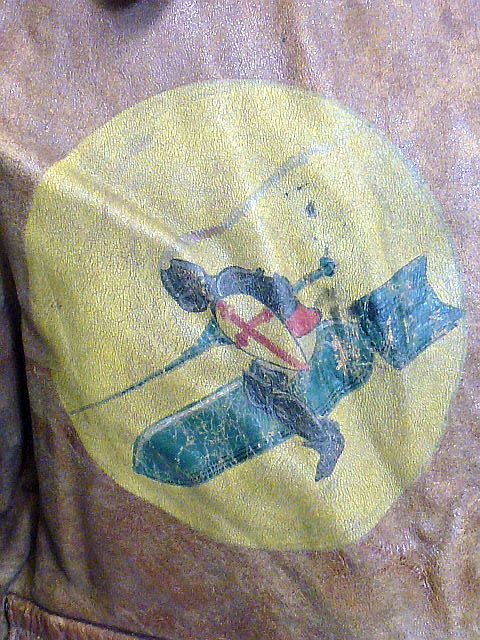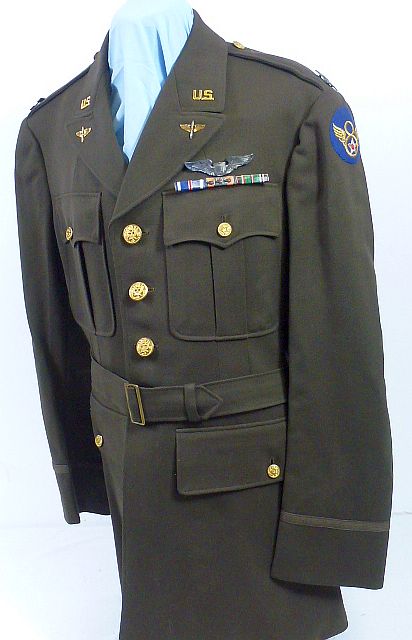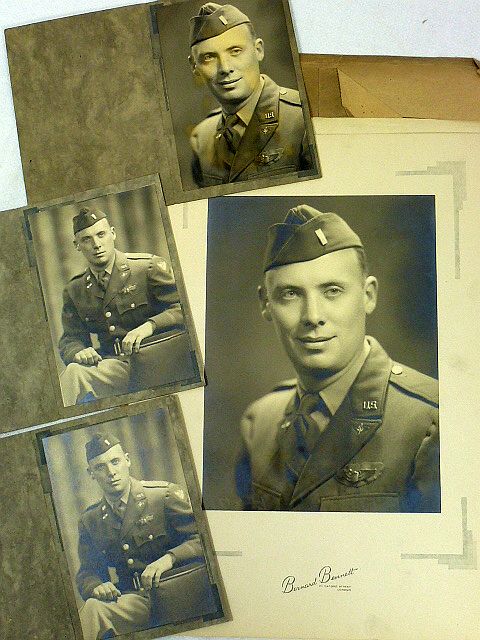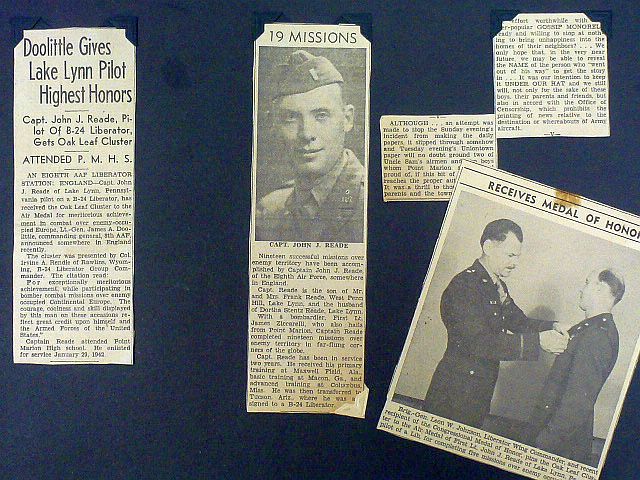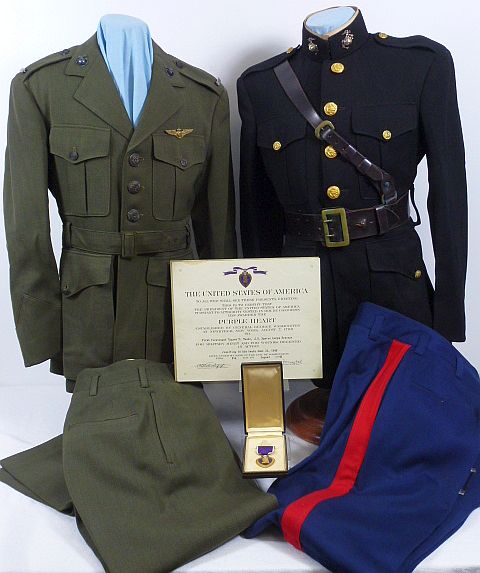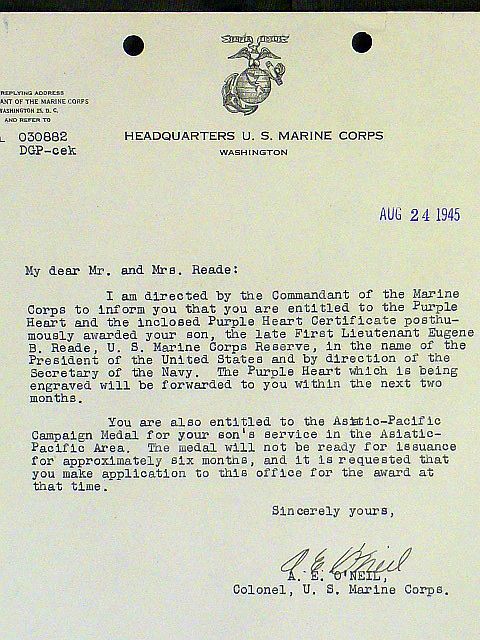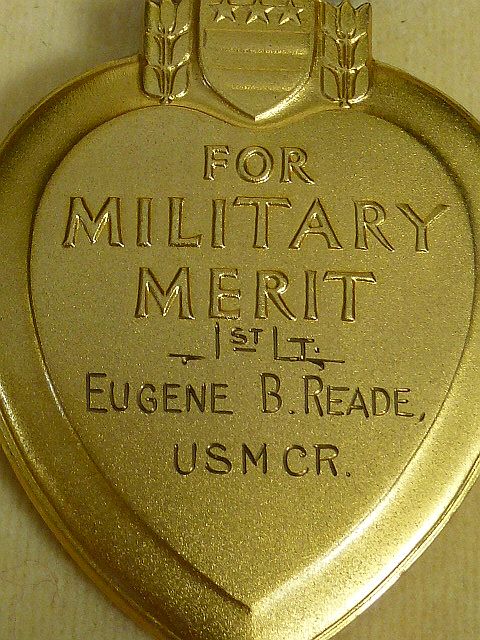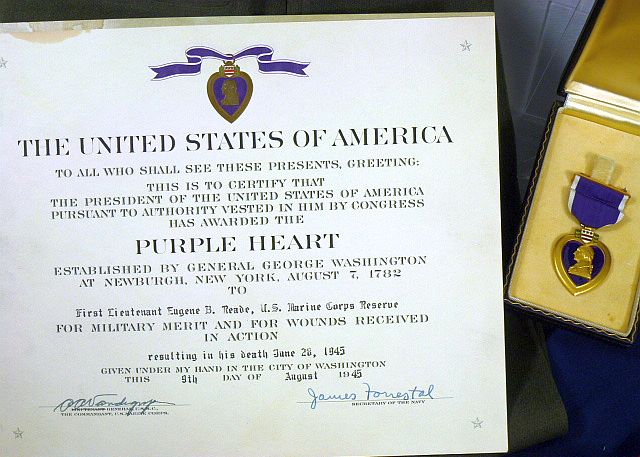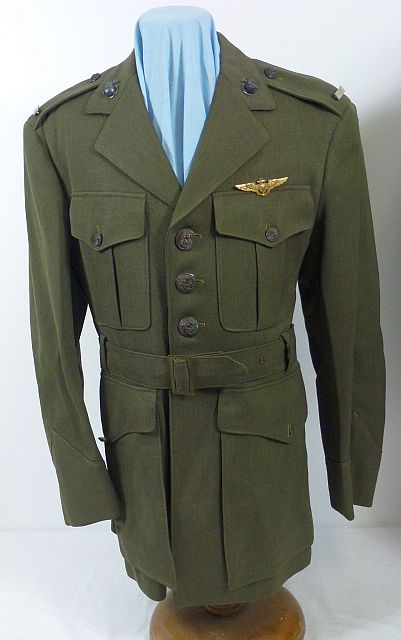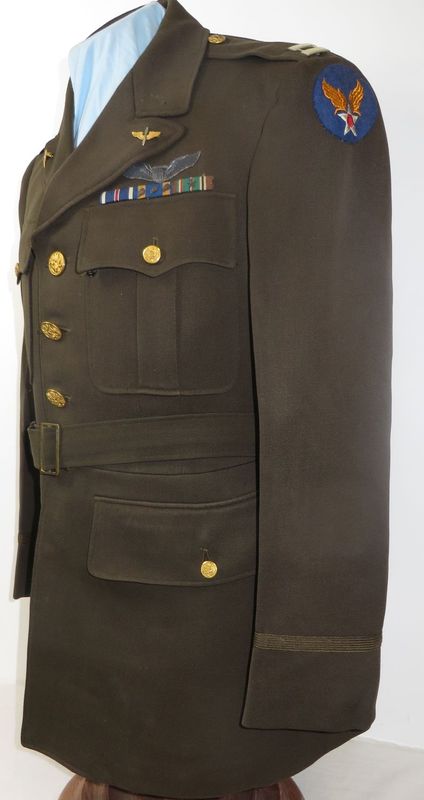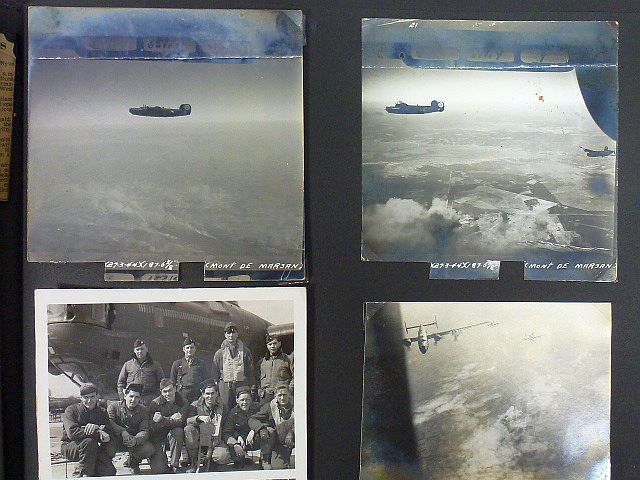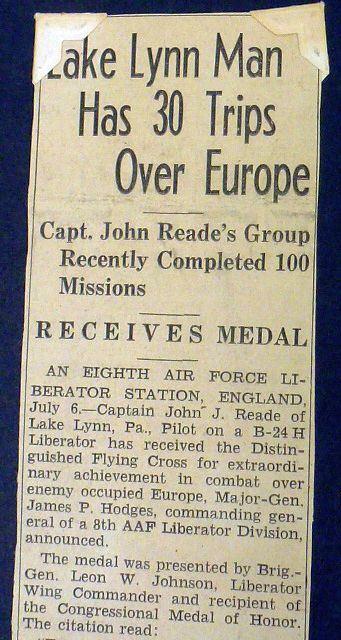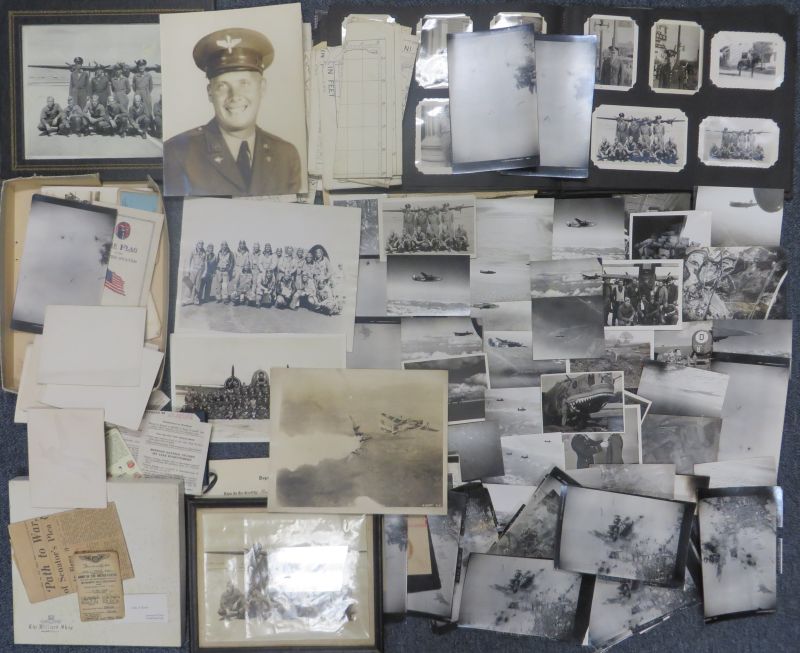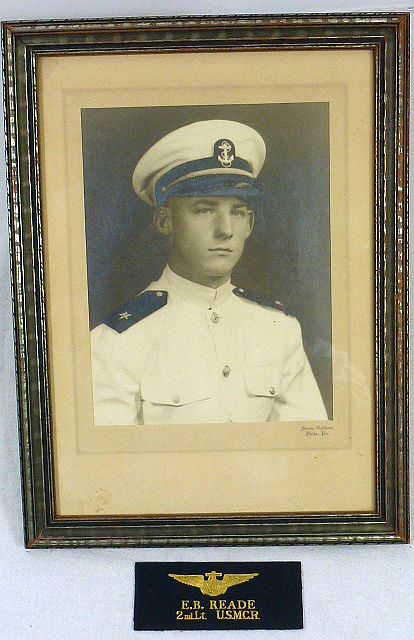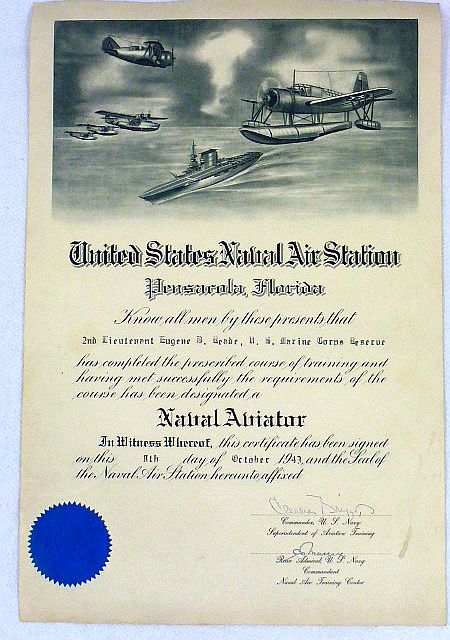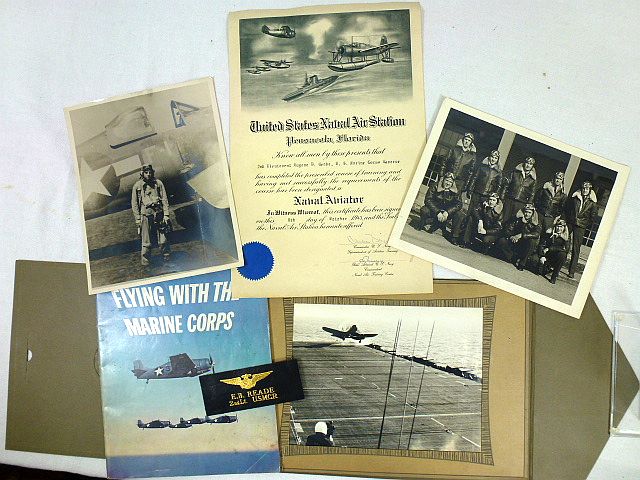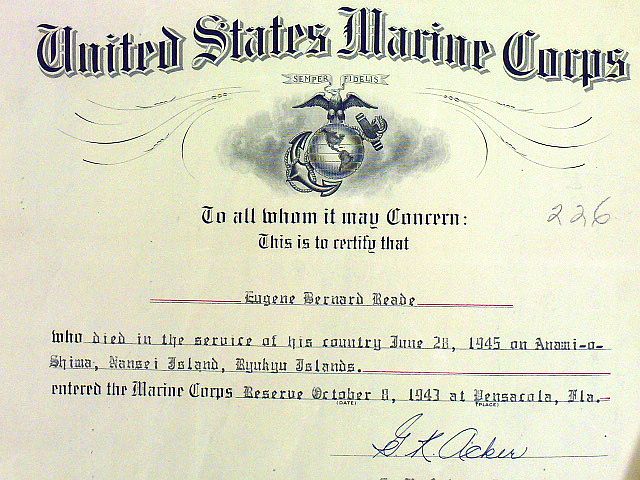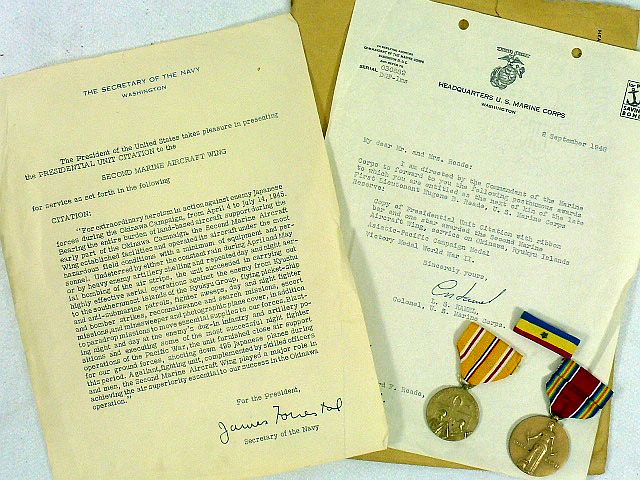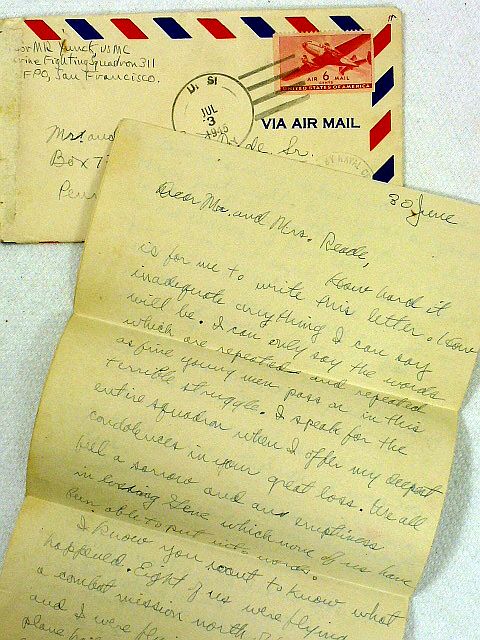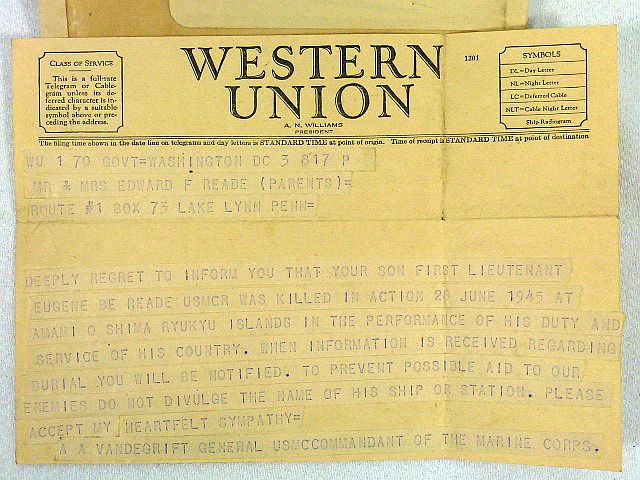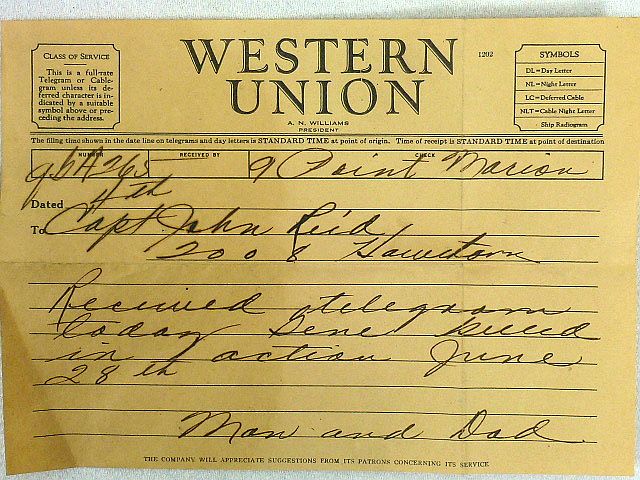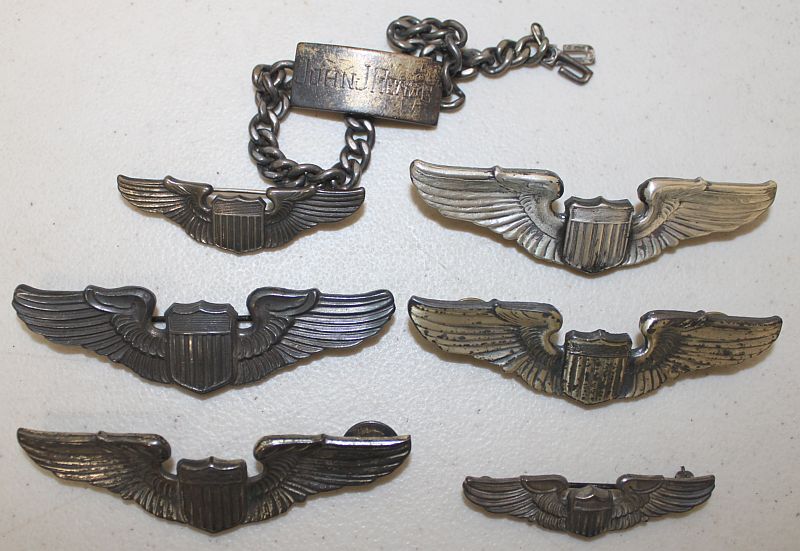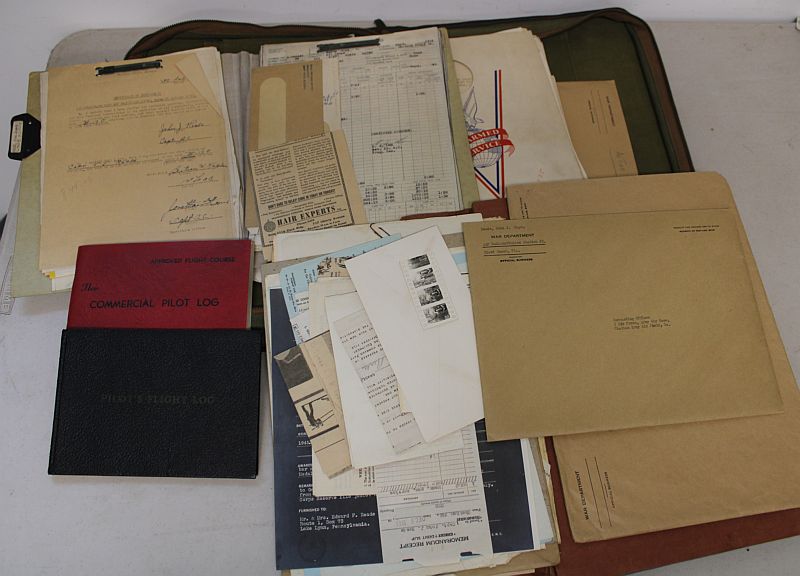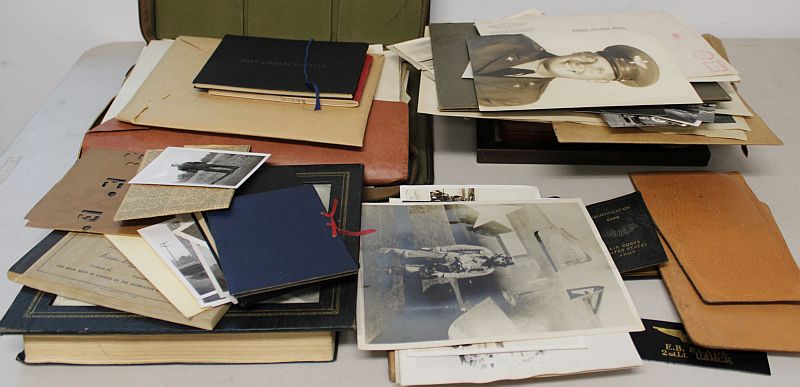Large and Extraordinary WWII Army Air Force and Marine Corps Aviation Group of Brothers John and Eugene Reade with Medal, Uniforms, Photographs, and Documents
$11,750.00
It is entirely appropriate to describe this group of World War II uniforms, medals, decorations, photographs, and documentation as, quite simply, one of a kind.
John and Eugen Reade were brothers from Lake Lynn, Pennsylvania. During the Second World War both served this country as military aviators.
John Reade piloted a B-24 Liberator called the “Flying Crusader”, flying 50 combat missions in the European Theater with the 392nd Bomb Group of the U.S. Army 8th Air Force. For his valor and his service he was decorated with the Distinguished Flying Cross, the Air Medal with oak leaf clusters, the European Campaign Medal and the World War II Victory Medal.
John’s brother, Eugene Reade, flew a Corsair fighter as a Marine Corps aviator with VMF-311 in the Pacific Theater of Operations. On June 28, 1945, while conducting a bombing and strafing mission in the battle for Okinawa, his plane was hit and he was forced to ditch at sea. While he was observed to have escaped the cockpit, he was apparently injured during either the attack or water landing and, after he evacuated his plane, he lost consciousness and died. He was posthumously awarded the Purple Heart, the Pacific Campaign Medal, the World War II Victory Medal, and the Presidential Unit Citation Ribbon with star.
This group, almost indescribably comprehensive in scope, is comprised of the uniforms, medals, decorations, photographs, and documentation of John and Eugene Reade, which have been preserved together for 75 years, and which have never before resided in a collection.
The group consists of the following items:
Captain John Reade, U.S. Army Air Force:
– Painted leather A-2 flight jacket, size 40. The jacket has on the right chest the painted insignia of the 392nd Bomb Group. On the left breast is painted an array of 28 bombs, above which is painted “Capt. J.J. Reade P-478”. It appears that Captain Reade ran out of room on the jacket for the bombs that represented his combat missions, since documentation in this assemblage of memorabilia confirms that he flew 50 missions with the group. The designation on the jacket of “P-478” came from the fact that the tail marking on the “Flying Crusader” was a “P” and the plane’s number, painted on its nose, was “478”. The jacket shows wear and use, with scuffing of the finish and fraying of the cuffs. However, the leather remains soft and supple, the painted embellishments are clear, and the Talon zipper is intact and working.
– Two Class A four pocket, belted, officer uniform tunics. One of the tunics has an English made 8th Air force wool shoulder patch; officer “US” and winged propeller collar insignia; pin back, sterling silver 3 inch pilot wings; and a plastic coated ribbon bar with the ribbons of the Distinguished Flying Cross, the Air Medal with 3 oak leaf clusters, and the European Campaign Medal. The interior of the jacket has a tag fastened to the lining on which is written “J.J. Reade”. The tunic is a size 38 regular. The other tunic has an embroidered wool Army Air forces shoulder patch. Above the left pocket a 3 inch bullion pilot wing is sewn to the tunic, beneath which is sewn a ribbon bar for the Distinguished Flying Cross, the Air Medal, and the European Campaign Medal with one large star mounted on it. This tunic lacks “US” collar insignia.
– Captain Reade’s visor cap, from which the wire stiffener in the crown was (of course) removed. The cap is a very high quality piece, having been made in London by the firm of J. Collett, Ltd. The interior label states that the cap was made “Expressly for the United States forces in European Operations”. The interior leather cap band has an impressed size of 7 1/8, and beneath the cap band is the British War Ministry broad arrow mark. There is some moth tracking to the top of the cap, but there are no holes, and the cap makes an excellent appearance.
– Two officer overseas caps, one in olive green wool and the other in pink gabardine wool. Both caps have Captain’s bars pinned to the front.
– Reade’s AN6540-2L leather flying helmet, size medium, in excellent condition.
– Captain Reade’s cased Distinguished Flying Cross, slot brooch, unnamed as awarded in the theater of operations, with lapel pin and ribbon bar; cased Air Medal, wrap brooch, with lapel pin and a ribbon bar with two oak leaf clusters; boxed European Campaign Medal; and boxed World War II Victory Medal.
– Reade’s War Department photographic officer’s identification card, issued to him in 1943 as a Second Lieutenant, holed punched “Inactive”.
– A large scrapbook containing documents and photographs relating to Reade’s service and his combat tour in Europe. Of particular note is an 8 by 10 inch presentation document that was prepared in the ETO by the 392nd Bomb Group and which was given to Reade upon his completion of 50 combat missions. There are numerous photographs in the album of Reade, his crew, and of B-24 Liberators in flight. There are also aerial photos of targets as the bombs are hitting them. Additionally, the album contains numerous articles that appeared in Reade’s hometown newspaper during his tour. The articles announce his mission tallies, the award of medals to him and, ultimately, his completion of 50 missions. Apparently Reade and his crew were the subject of at least two lengthy articles by journalists assigned to the ETO, and these articles are in the album (one article focuses on Reade’s bombardier, and it is in that article that the name of their bomber is found).
– Leather “Pilots Navigation Kit” containing Reade’s order’s and records. This file is about 4″ thick.
– There are more than 60 additional photographs that were not mounted in the album. These comprise additional photos of B-24’s, their crews, Reade himself, and aerial photos of bomb impacts during missions.
– Reade had his photographic portrait made at a London photographer’s studio during the war. There are two large and several smaller portrait photographs of Reade in uniform from this session, one of which is in a period frame. There are also several 8 by 10 photographs of Reade and his crew in front of a B-24 bomber.
– The group includes Reade’s sterling silver identification bracelet, engraved on one side with his name and on the other with his officer’s service number.
– There are four pair of 3 inch pilot wings. Of these, one set of wings is sterling, pin back, by N.S. Meyer; a second pair of wings is sterling, clutch back, by A.E. Company; the other two pair of wings are clutch back and unmarked. There are also two pair of 2 inch pilot wings for the uniform shirt. Both are sterling and pin back. There are two sets of Captain”s bars as well.
– The documentation also includes the certificate attesting to Reade’s certification as a qualified private pilot, which he earned in 1940.
– A small copy of the New Testament, in a protective leather zipper cover, with an interior note that it was given to Reade on April 2nd, 1942, by his Grandmother.
– Two U.S. Army Air Forces Type E-6B Aerial Dead Reckoning Computers, each contained within their leather cases.
– 13 small size black and white maps, each dated as having been prepared in 1943, and each one encompassing England and western Europe. Each map has notations on it. Many of the maps have the entire course of a bombing mission diagrammed on it, including notations such as “Secondary Target”.
Lieutenant Eugene Reade, U.S. Marine Corps:
– U.S. Marine Corps officer dress blue uniform, comprised of the tunic, trousers, and black leather Sam Browne belt, with magnificent sterling and gold Marine Corps officer collar insignia. The white collar liner remains in place. The interior pocket is named to “E.B. Reade” and is dated September of 1943.
– Green Marine Corps officer service uniform, comprised of the belted green tunic with two pair of trousers. Additionally there is the matching green wool Marine Corps officer’s overcoat. The interior jacket pockets of both the overcoat and the service uniform are named to “E.B. Reade” and dated August of 1943. One pair of uniform trousers obviously saw more use than the other, as they show some fraying at the edges of the side pockets and on the bottom of the legs. Above the left breast pocket of the uniform jacket is a set of full size pin back wings of a Naval Aviator, maker marked by Hilborn Hamburger.
Both of the uniforms, as well as the overcoat, were tailored by S.W. Rice of Baltimore and Pensacola. The uniforms and overcoat are in beautiful condition, and they were obviously sent home to Lieutenant Reade’s family after he was killed in action.
– A Western Union telegram, addressed to Reade’s parents:
“Deeply regret to inform you that your son First Lieutenant Eugene B Reade USMCR was killed in action 28 June 1945 at Amami O Shima Ryukyu Islands in the performance of his duty and service of his country. When information is received regarding burial you will be notified. To prevent possible aid to our enemies do not divulge the name of his ship or station, Please accept my heartfelt sympathy. A.A. Vandegrift General USMC Commandant of the Marine Corps.”
– Cased posthumous Purple Heart. The decoration is the Navy style, on a gilt full wrap brooch, contained within the black leather Navy case, which was somewhat smaller than the Army cases and which lacked the overhanging edges on the lid. The Purple Heart is officially engraved “1st Lt. / Eugene B. Reade / USMCR “.
– The large formal award document for the Purple Heart decoration that was awarded posthumously to Eugen Reade, contained within its original mailing envelope.
– A lengthy handwritten letter to Reade’s parents dated 30 June of 1945, and written by Major Michael Yunck, the commanding officer of squadron 311. Major Yunck’s letter was more than an expression of sympathy. As he wrote Reade’s parents, “I know you want to know what happened. Eight of us were flying on a combat mission north of here. Gene and I were flying together. Gene’s plane had engine failure. He decided to land in the water. The choice was wise, rather than bailing out as our planes have very good water landing characteristics. Gene was very calm and did everything just right. He made a good landing but a rather hard one due to the water. I flew over the plane before it sank and saw Gene out of the cockpit. I could not tell whether he was moving or not. The third time I flew over I could not see Gene. Since he was out of the cockpit I can only assume that he was injured by the landing and passed out in the water. The area was thoroughly searched for two days even though it was hopeless. On the basis of my seeing him and then his disappearance and the thorough search which was conducted Gene has been declared killed in action rather than missing in action. If I could offer the slightest hope I would do so. I am sure though that Gene passed on quickly and did not suffer.”
Major Yunkc’s letter goes on the express the sympathies of both himself and the entire squadron, noting that Gene Reade was both a very skilled pilot and much admired by his fellow Marine aviators. The letter is interesting since there are accounts of that day in the historical records which relate that Gene Reade’s plane was disabled as a result of enemy fire. Major Yunck, however, told Reade’s parents that he had suffered an engine failure. Perhaps the engine failure was in fact caused by the enemy fire, and Yunck was somehow attempting to soften the already terrible news. Nevertheless, Yunck’s letter, like all of the other material in this remarkable group, was carefully preserved, even with its original mailing envelope.
– Eugene Reade’s posthumously awarded Pacific Campaign Medal, Victory Medal, and Unit Citation ribbon. These are with the original letter from the Marine Corps forwarding them to Reade’s parents after the war. They also included a copy of the citation the led to the Distinguished Unit award. They are with their original mailing envelope.
– The large, formal 10 inch by 15 inch document recognizing that Eugene Reade of the United States Marine Corps Reserve had been designated a “Naval Aviator”, dated October 8, 1943.
– Following the end of the war, Reade’s parents submitted several original documents to the Pennsylvania World War II Veterans’ compensation Bureau. The Bureau replied, advising Gene’s parents that they would receive compensation in the amount of $500. The original documents that Gene’s parents submitted to the Bureau remain stapled to the Bureau’s response. Those documents include a condolence letter sent to Mr. and Mrs. Reade by Major General field Harris of the Marine Corps, dated 9 July 1945; a letter of condolence dated 5 July 1945, signed by General A.A. Vandegrift, the Commandant of the Marine Corps; and a formal 8 by 10 inch engraved document from the Marine Corps, attesting to the fact that Eugene Bernard Reade had died in the service of his country on June 28, 1945. The reverse of the document provides his dates of service and his medals and decorations. The letter from the Bureau is, like many other documents, still contained within its original mailing envelope to Gene’s parents.
– The group also includes multiple photographs of Gene Reade while in the service. Included as well are his two Flight Log Books and two leather name tags with gold Naval Aviator wings for wear on a flight jacket.
One other item in this group should be mentioned, although it should be observed here that, due to the extraordinary extent of this group, there are many pieces of documentation or memorabilia that have not been specifically described. However, it will be noted in closing this description that included with this group is one more telegram. Like all telegrams of that period, it was recorded on very lightweight, even flimsy paper. Yet it has survived and, again, it is contained within its original envelope. This small piece of paper served to briefly unite the Reade family in grief, as so many other American families grieved in that period of history. The message was addressed to Captain John Reade, and it stated simply: “Received telegram today Gene killed in action June 28th. Mom and Dad.”
Sold!

